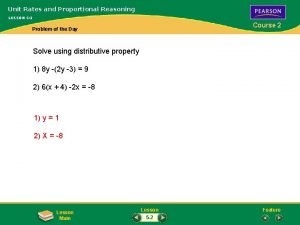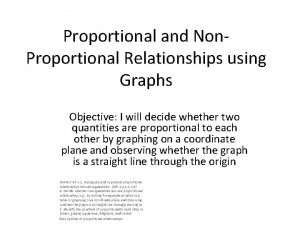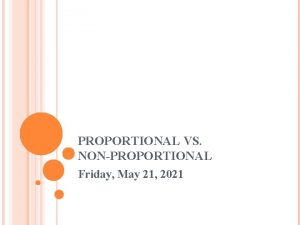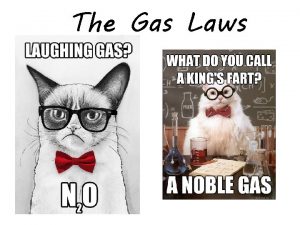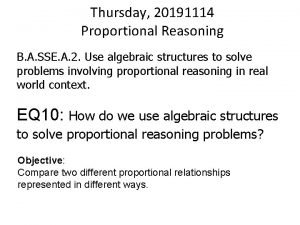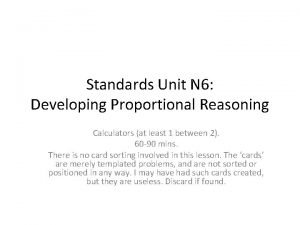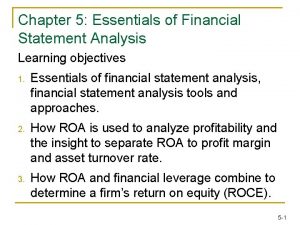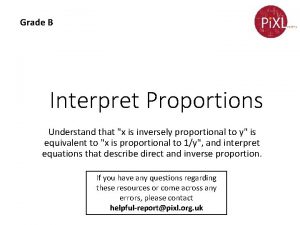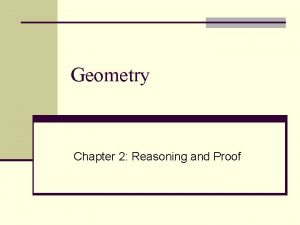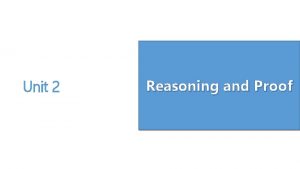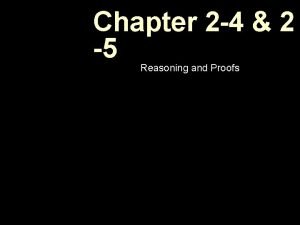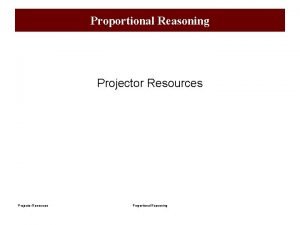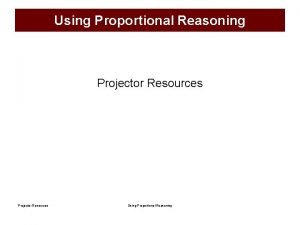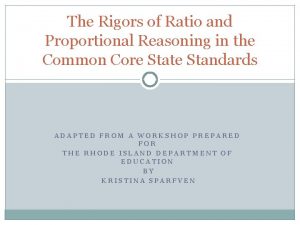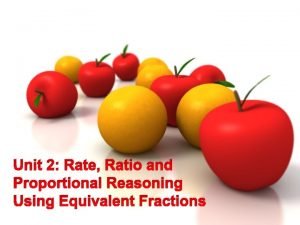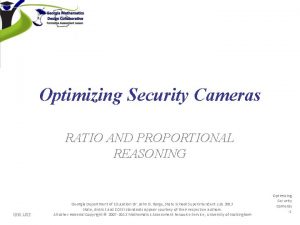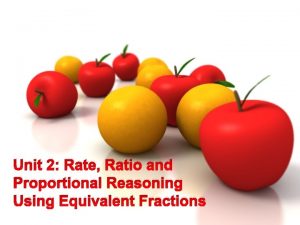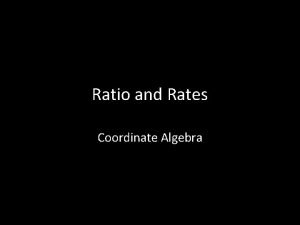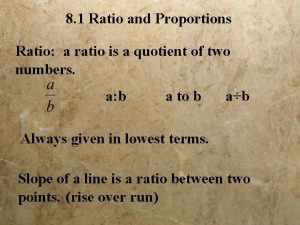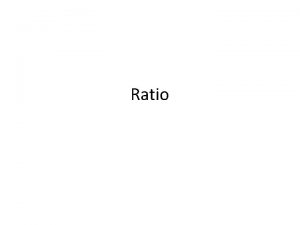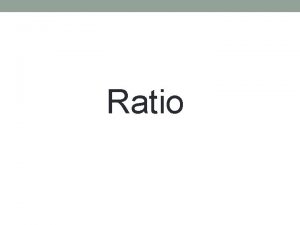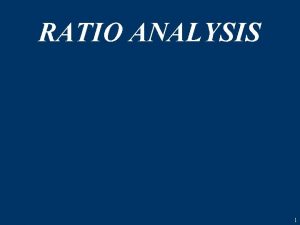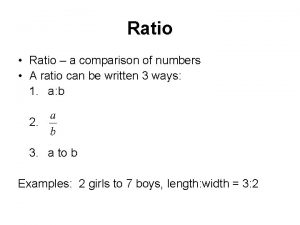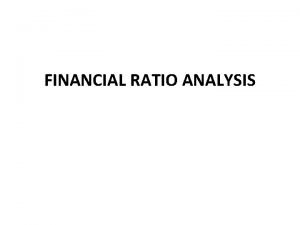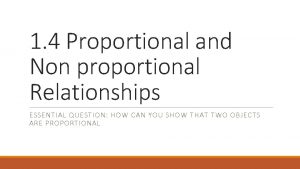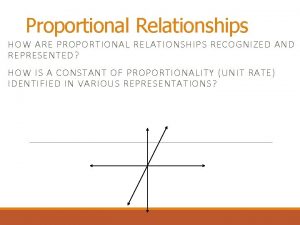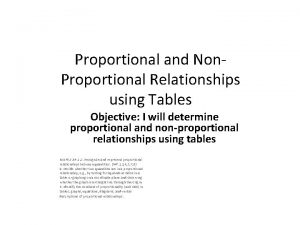Chapter 7 Ratio and Proportional Reasoning The Meaning








































- Slides: 40

Chapter 7. Ratio and Proportional Reasoning The Meaning of Ratio, Rate and Proportion Solving Proportion Problems by Reasoning with Multiplication and Division Connecting Ratios and Fractions When You Can Use Proportion and When You Cannot? Percent Revised: Percent Increase and Decrease

The Meaning of Ratio, Rate, and Proportion • Rate • Ratio • Proportion

Ratio A ratio (notations: A to B, A: B, A/B) describes a relationship between two quantities measured in the same unit Definition - “How many groups? ” A ratio of A to B of two quantities means that for every A units of the first quantity we must have B units of the second. Definition - “How many in each group? ” Two quantities are in a ratio of A to B provided if we divide the first quantity into A equal parts, then the second quantity is divided into B equal parts of the same size as A.

Example. Ratios arise naturally when we make mixtures of substances. The ratio of flour to milk in a muffin recipe is 7 to 2. This means: for every 7 cups of flour we need 2 cups of milk. The ratio 7: 2 viewed as groups of 7 and groups of 2 The ratio 7: 2 viewed as 7 groups and 2 groups

Rate A rate is a ratio between two quantities that are measured in different units. Examples. • Speed as a rate: measures distance traveled per amount of time (if a car has speed 100 km/h it means that the car travels 100 km in 1 hour) • Pulse rate: number of beats per minute • Unit price: e. g. how much apples cost per 1 kg

Proportion A proportion is a statement that two ratios are equivalent Example. The equation 7: 2 = 14: 4 is a proportion.

Note. In general if we have a ratio of A: B (where A and B are positive whole numbers), then A: B is equivalent to N∙A : N∙B. Example: To make orange paint we need a ratio of red paint to yellow paint of 1: 3. How much orange paint will we make by using 2 ½ cans of red paint?

Solution.

Solving proportion problems by reasoning with multiplication and division There will be three different methods for reasoning about multiplication and division to solve ratio and rate problems: I) Finding the amount in one part II) Comparing like quantities III) Comparing unlike quantities

Finding the amount in one part Problem. At a perfume factory, the workers want to mix rose oil and lily of the valley oil in a ratio of 4 to 3. How much rose oil will the workers need to mix with 24 liters of lily of the valley oil? Finding how many liters in each part (of the three) in lily oil: 24÷ 3 = 8 Thus the workers will need to use 4 x 8 liters = 32 liters of rose oil.

Comparing like quantities Problem: John used 4 gallons to drive 100 miles. Assuming that John continues to get the same gas mileage, how far will John be able to drive with 20 gallons of gas? Reasoning:

Note. The method of solving by comparing like quantities is similar to solving by equivalent fractions.

Comparing unlike quantities Problem: John used 4 gallons to drive 100 miles. Assuming that John continues to get the same gas mileage, how far will John be able to drive with 20 gallons of gas?

Going through 1 to make numerical calculations easier Problem. A muffin recipe calls for a ratio of flour to milk of 7 to 2. Now, we have to make the muffins in 4 cups of flour. How much milk do we need to use?

Problem. An aquarium contained an equal number of horseshoe crabs and sea stars. After 15 horseshoe crabs were removed and 27 sea stars were removed, the ratio of horseshoe crabs to sea stars was 5: 3. How many horseshoe crabs and sea stars were there at first? Solve this problem and explain your reasoning.

Connecting ratios and fractions • Ratios are often written as fractions, but we define ratios and fractions differently • The connection between a ratio and a fraction is the unit rate Given the ratio A: B of two quantities, the fraction A/B is a unit rate that tells us how many units there are of the first quantity for 1 unit of the second quantity

Connecting ratios and fractions Similarly, given the ratio of two quantities A: B, the fraction B/A is the unit rate that tells us how many units are of the second quantity for 1 unit of the first quantity.

Solving proportions by cross-multiplication • Write ratios or rates as fractions and set two fractions equal to each other (form a proportion) - When we set up the two fractions, they must stand for the same unit rate • Cross- Multiply - If the fractions stand for the same unit rate, then they are equivalent • Solve the resulting equation


Example (continued) Interpret the two fractions you set equal to each other. Explain why it makes sense to set these two fractions equal to each other. In the given rate we had rice : no. of people If we set it as a unit rate we get each fraction as cups of rice allotted to each person:

Example (continued) Why does it make sense to cross-multiply the two fractions? What is the logic behind the procedure of cross-multiplication? Cross-Multiplying is the same as finding the common denominator of the fractions and writing the two fractions in an equivalent form with same denominator. The common denominator of the two fractions is 48. Because the two fractions are equal to each other and because they have the same denominator, then the numerators must be the same.

Example (continued) Solve the problem in a different way, using logical thinking. ½ cups If 6 people need 1½ cups of rice, then for each 2 people we need ½ cups of rice. Thus for 8 people we need 4 x ½ cups of rice, which makes 2 cups of rice in total.

When you can use proportion and when you cannot? • The answer to this question is not as straightforward as it seems • Usually when we use proportion, we construct two fractions that are equivalent with each other • These equivalent fractions are made up of pairs of quantities that are related • There are instances, in which the quantities in a problem might seem related, but not well enough to set it up as to solve it through equivalent fractions.

Problem Driving at 50 mph, you covered the distance between two markers in 75 seconds. How long would it take you to cover that same distance driving at 60 mph?

Proportional vs. Inversely proportional Relationships Example. Suppose that 2 people take 8 hours to mow 15 acres of grass. We assume that all the people work together at the same time and at the same steady pace.



Problem If a crew of 3 people takes 2 ½ hours to clean a house, then how long should it take for 2 people to clean the same house? Assume that all people in the cleaning crew work at the same steady rate. Solve this problem by using logical thinking and the most elementary reasoning you can. Explain your reasoning clearly.

Problem. A candy factory has a large vat into which workers pour chocolate and cream through special hoses. Workers in the factory know that it takes 20 minutes to fill the vat with chocolate and 15 minutes to fill the vat with cream. If the workers pour both chocolate and cream at the same time in the vat, how long does it take to fill the vat? Explain your reasoning.

Percent revised: percent increase and decrease Percent Increase If the value of a quantity goes up, then the increase in the quantity figured as a percentage of the original is called percent increase Percent Decrease If the value of a quantity decreases, then the decrease in the quantity figured as a percentage of the original is called percent decrease

Two methods of calculating percent increase or decrease First Method Suppose that a quantity is changing from an amount A to an amount B: I) Calculate the change : I) Calculate the percent that the change C is of the reference amount A.

Second Method Suppose that the amount A is changed to an amount B I) Calculate B as a percentage of A II) If A represents 100% then the percent increase / decrease is:

Example. If a table costs $ 279 last week, and this week the same table costs $ 319, what is the percent increase? Solution: Method II

Example. If a person’s weight dropped from 250 pounds to 225 pounds, by what percent did the person’s weight decrease? Solution: Method II

Two methods for calculating amounts when the percent increase or decrease is given First Method – if the original amount is given If the percent increase/decrease and the original amount are given, calculate the increase, and then add/subtract to/from the original amount to calculate the final amount.

Second Method – if the final amount is given We use the second method to find the initial amount when we know the percent increase or decrease and the final amount.

Problem. If a table costs $187 and if the price of the table goes up by 6%, what will be the new price be?

Problem. If the price of gas went up (down)5% and is now $2. 15 per gallon, how much did the gas cost before the increase (decrease)?


Note • In all problems involving percentage increase and decrease we must be aware of the reference amount • Often, the reference amount is the initial quantity and represents the whole or 100%
 Course 2 chapter 1 ratios and proportional reasoning
Course 2 chapter 1 ratios and proportional reasoning Non-proportional graph
Non-proportional graph Inversely proportional
Inversely proportional What does non proportional mean
What does non proportional mean Proportional vs nonproportional
Proportional vs nonproportional Proportional vs non proportional graphs worksheet
Proportional vs non proportional graphs worksheet Indirectly proportional
Indirectly proportional Practice proportional reasoning with scale drawings
Practice proportional reasoning with scale drawings Proportional reasoning calculator
Proportional reasoning calculator Proportional reasoning calculator
Proportional reasoning calculator Inductive vs deductive reasoing
Inductive vs deductive reasoing Inductive reasoning and deductive reasoning
Inductive reasoning and deductive reasoning Reasoning vs evidence
Reasoning vs evidence Inductive argument
Inductive argument Deductive logic definition
Deductive logic definition Inductive vs deductive geometry
Inductive vs deductive geometry Inductive reasoning is reasoning based on patterns
Inductive reasoning is reasoning based on patterns Acid test ratio and quick ratio
Acid test ratio and quick ratio Genotypic ratio and phenotypic ratio
Genotypic ratio and phenotypic ratio Current ratio and quick ratio
Current ratio and quick ratio Directly proportional equation
Directly proportional equation Rr statistics
Rr statistics Simple machine gears
Simple machine gears Secondary reinforcers
Secondary reinforcers Ukuran asosiasi
Ukuran asosiasi Geometry chapter 2 proofs worksheet
Geometry chapter 2 proofs worksheet Chapter 2 reasoning and proof answer key
Chapter 2 reasoning and proof answer key Chapter 2 reasoning and proof answer key
Chapter 2 reasoning and proof answer key Hình ảnh bộ gõ cơ thể búng tay
Hình ảnh bộ gõ cơ thể búng tay Frameset trong html5
Frameset trong html5 Bổ thể
Bổ thể Tỉ lệ cơ thể trẻ em
Tỉ lệ cơ thể trẻ em Chó sói
Chó sói Tư thế worms-breton
Tư thế worms-breton Hát lên người ơi alleluia
Hát lên người ơi alleluia Môn thể thao bắt đầu bằng chữ đua
Môn thể thao bắt đầu bằng chữ đua Thế nào là hệ số cao nhất
Thế nào là hệ số cao nhất Các châu lục và đại dương trên thế giới
Các châu lục và đại dương trên thế giới Công thức tiính động năng
Công thức tiính động năng Trời xanh đây là của chúng ta thể thơ
Trời xanh đây là của chúng ta thể thơ Mật thư tọa độ 5x5
Mật thư tọa độ 5x5
